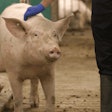University of Connecticut researchers have identified a novel small molecule that could be used to develop preventative treatment for porcine reproductive and respiratory syndrome (PRRS) virus.
Researchers from the College of Agriculture, Health and Natural Resources have identified a small molecule that can successfully disable the virus’ mechanisms for reproducing and evading the host organism’s immune system.
The researchers began by using artificial intelligence to screen a bank of small molecules to identify which ones might be good candidates. The algorithm compared the structure of the viral protein the researchers wanted to target against those of the small molecules.
They then narrowed their results down to a single chemical that could inhibit the virus without producing toxic effects.
The researchers targeted a protein called NendoU. This protein is highly conserved, meaning that when the virus mutates, this protein will likely stay the same because it plays such an essential role in the virus’ ability to reproduce.
The researchers found that the number of viral particles in cells treated with the small molecule was more than 1,000 times fewer than the untreated control group.
“Basically, the virus comes into the untreated cell and uses the cell’s machinery to amplify and create more viruses,” said Xiuchun “Cindy” Tian, UConn professor of animal science. “So, if you treat the cells with this particular chemical, compared to untreated cells, it’s going to reduce it by 1,000 times in terms of viral number.”
NendoU is also common across other closely related viruses.
“We were thinking this (chemical) could also work on other viruses in this order,” said graduate research assistant Jiaqi Zhu. “So, we tested it on another virus called chicken infectious bronchitis virus and it also worked very well.”
Findings were published in the Journal of Virology.

















